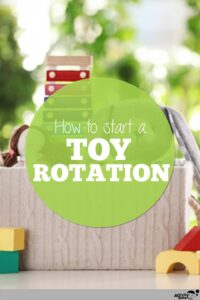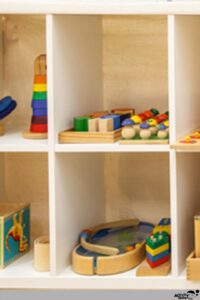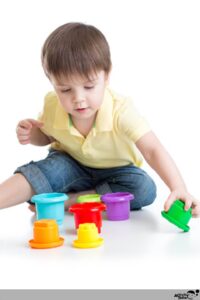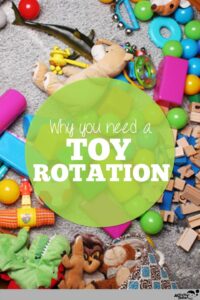
Does your little one drift from activity to activity, but doesn’t settle down with any of them?
Are you constantly overwhelmed by stuff?
Try toy rotation!
Oftentimes, littles ones are overwhelmed by the number of toys at their disposable, rather than bored. By limiting the number of toys available to a child at one time, you will promote deeper, more creative play and help expand attention skills!
How does toy rotation work?
Rotating toys involves presenting a limited number of toys to a child. The set of available toys usually changes each week. Adjust the time frame based on your child’s age and what works for you. Younger children may need more frequent changes.
Choose 10-12 toys to rotate weekly. Select the toys each week or create four bins of toys each month and swap one out each week. Do what works best for YOUR FAMILY!
Quick tips:
- If you’re just starting, do an initial toy purge. Throw away anything broken and donate toys no one has played with in awhile or completely outgrown.
- Offer an assortment of toy types within the group like a puzzle, a play set, a riding toy, and blocks. Some families do an initial organizing of all the toys they have, dividing them into categories like fine motor, pretend play, games, gross motor, etc.
- Books don’t count! An assortment of books should always be available. Have some seasonal, some well-loved favorites and a couple newer selections.
- A toy may be a set like a Lego set or farm with animals. If you have a ton of accessories for a play set, you might want to divide it up.
- No need to be ultra-rigid. You might have an extra toy one week and one less the following. If your child seems to be getting bored (or you need them to have more of a diversion one day), swap the toys out early.
- Big, hard-to-store toys like an indoor slide can stay out.
- A couple of favorites or loveys can stay out.
Remember, embracing toy rotation doesn’t require you to suddenly become a minimalist! Keep as many of your toys as you’d like, but limit how many are accessible at once.
The goal here is to help your children play MORE with fewer toys instead of fluttering back and forth between so many different toys.
As your child begins to play more with their toys, they will also begin to play LONGER! Longer play sessions result in increased sustained attention.
Why is sustaining attention so important?
- Sustained attention is a major part in one’s ability to learn and process information.
- The ability to attend/focus is linked to self-control. It plays a big part in learning how to regulate our emotions.
Sustained attention to an activity also has benefits for language development. Late talkers especially do better with a “less is more” approach when they are adding expressive vocabulary (the words they say). Immersing them in more limited vocabulary may help them acquire words more quickly.
Bonus!
For many parents, visual clutter is overwhelming and a source of stress. Removing toy clutter may also do wonders for your peace of mind!
Are you wondering what toys and books an early childhood expert recommends? Check out my Amazon storefront!
As an Amazon affiliate, I may receive a small commission when you use the links in my post. There is no increase in the price you pay!
Looking for more information on building your child’s attention span? Try the Building Attention webinar!
Remember…
It is tempting to frequently offer more or new toys to a child who wanders around but never chooses an activity. They look bored, and you want to help. It’s more likely they are overwhelmed by all the choices and distractions and can’t settle on any single task.
Limiting the number of toys will help your child play more deeply and creatively with what is available while also increasing their attention span.
It may take a few weeks for both you and your child to get into the swing of a toy rotation habit. Stick with it! The benefits are worth it.
SLPs, do you need a handout to share with parents?









